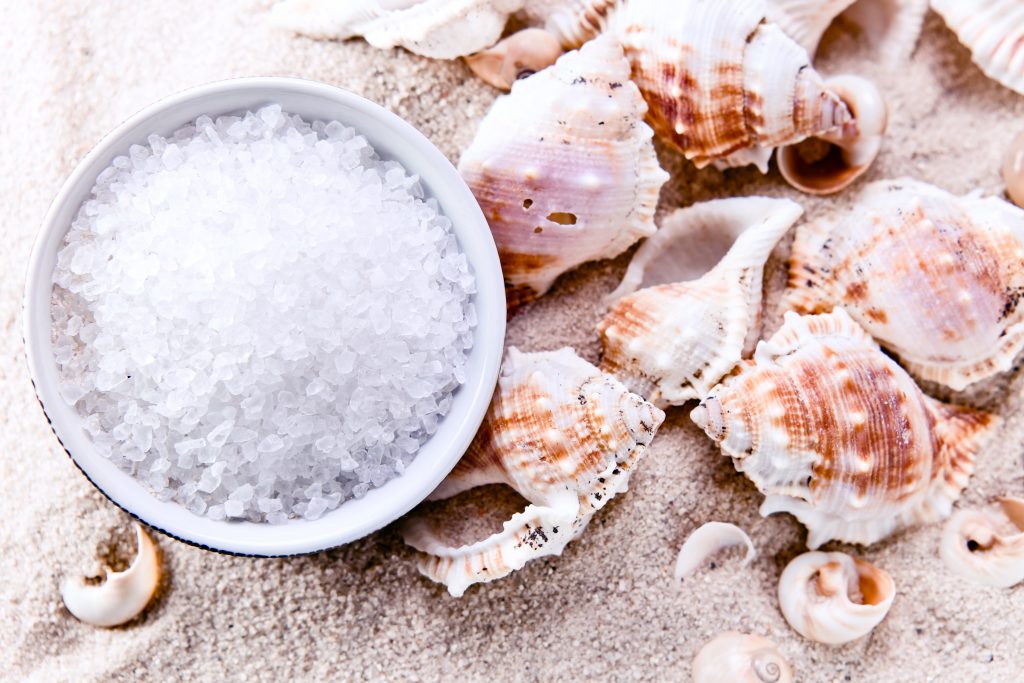On one hand, we prepare homemade salt scrubs and use salty sea water to create beach weaves. On the flip side, we know that when used in excess, it might dehydrate skin and cause irritations. However, do we know all beauty benefits that salt offers? Do we know how to use it to our advantage?
The trend for frequent use of salt in hair and body care has its beginning in Korea, where actually all novelties in the field of beauty come from. It wasn’t long that American and European women become crazy about the beauty benefits of salt.
Salt in cosmetics – good and bad sides
Some people warn us that the excess of salt might harm our skin. The others emphasize that salt has very interesting properties and we shouldn’t be afraid of using it. What’s the truth?
The secret lies in the balanced use of salt to treat our bodies and hair with. Indeed, there are two faces of salt:
- on one hand, it delivers outstanding properties when used as an exfoliating agent in scrubs, it allows hair to boost its volume and even offers medicinal properties (in physiotherapy there are many ailments that are treated due to salt);
- on the other side, when used externally, salt removes water from body, may dehydrate skin and hair as well as cause micro-damages and irritations.
Salt in hair and body care. Is it worth using?
Nowadays, the Korean are trying to convince the entire world that salty body and hair care can be effective. They even claim that this type of care displays anti-acne properties. How much truth is in this conviction?
Quite a lot. Owing to their properties, cosmetics containing salt can be used by people struggling with reoccurring acne and oily skin. These are the cases when it’s a good idea to give a try to salt body and hair care and replace sugar scrub with salt scrub.
Special attention should be paid by sensitive and dry skin type owners – grains of salt might dehydrate and irritate skin.
Beauty benefits of salt
What are the beauty benefits of salt. Why did Asian people fall in love with cosmetics containing salt? It’s because natural salt:
- absorbs the excess of sebum effectively;
- displays antibacterial properties;
- is good at exfoliating dead epidermis cells;
- balances skin’s pH level;
- delivers essential minerals;
- leaves skin soft and smooth;
- improves micro-circulation of blood in skin.
Which type of salt to choose?
There are a few types of salt that are worth being introduced into daily hair and body beauty routine. Note: not necessarily should we reach for rock salt because its nourishing substance content is the lowest among all the salt types.
A definitely better solution is the use of sea salt or Himalayan salt – these salt types contain many mineral substances that are absorbed by skin during the beauty procedures. Less known yet equally valuable are Kala Namak (also known as Himalayan black salt) or Epsom salt (also called bitter salt). Both of them serve beauty purposes really well.
Types of salt and their properties
- SEA SALT – isn’t purified therefore it features plenty of minerals such as potassium, calcium and iron. The most frequently it originates from the Dead Sea. It’s widely used for brine bath as well as for preparing homemade salt and oil scrubs.
- HIMALAYAN SALT – it can be recognized by its light pink colour and rather big crystals. It’s exploited from the mineral deposits that are located 400-600 m below ground level. It’s rich in sodium chloride and almost 80 various elements! Himalayan salt is especially recognized for its abilities to treat problematic skin type.
- EPSOM SALT – it’s also called English salt and it’s mainly used to produce solutions that bring relief and deal with various skin ailments. Its composition features sulphur and magnesium compounds. Thanks to this, Epsom salt can be used as a component of scrubs, facial masks, foot baths and baths in general.
- KALA NAMAK SALT – despite being named ‘black’, its colour is rather grey-and-pink. The most interesting though is its taste and smell: it doesn’t resemble salt at all, but rather an egg! It’s mainly composed of sodium chloride as well as many other minerals which makes it a valuable component of body and hair care products.
Cosmetics with salt
The most typical cosmetics featuring salt are scrubs that can be either bought in a drugstore or prepared at home (salt has to be mixed with natural oils or favourite body balm). Also, it can be used for brine bath and hair styling products.
Additionally, owing to the Koreans we know that salt can be also added to toners, creams and face cleansing products. It’s a good idea to give a try to the very cosmetics since they are remarkably effective because of salt properties.



Leave a Reply